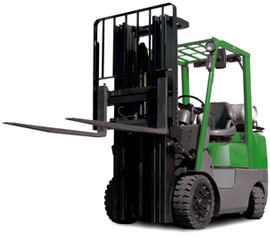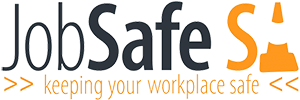 Forklifts are used in workplaces such as warehouses, factories and freight terminals to perform most of the heavy lifting and stacking. Before the use of forklifts, people performed many of these activities through manual handling and consequently the use of forklifts has reduced the number of manual handling injuries in these workplaces.
Forklifts are used in workplaces such as warehouses, factories and freight terminals to perform most of the heavy lifting and stacking. Before the use of forklifts, people performed many of these activities through manual handling and consequently the use of forklifts has reduced the number of manual handling injuries in these workplaces.
Nonetheless, a forklift is not a recreational vehicle. It is not designed for any purpose other than work and it must be operated according to safe operating procedures. Guards should be fitted to protect employees from hot parts, moving parts and exposed wheels. However, overhead guards should not prevent the operator from having adequate visibility and must conform to Australian Standards.
Types of forklift accidents which can cause injuries include:
- Being struck by a moving forklift
- Forklift tipping over and overturning
- Collision with other vehicles or stationary objects
- Part of the operator’s body protruding out of the cabin and hitting an object
- Losing the load
Start-up safety procedures
It is necessary that a set of safety operating procedures is implemented for every workplace device. These procedures should be regularly updated and made available to all staff via training sessions.
Before starting each shift, conduct a pre-operational inspection of the forklift truck and any attachments such as lift and tilt systems, tyres, warning devices and load arms. These checks can reduce the risk of machine faults that may cause accidents.
Check fluid levels:
- Engine oil
- Hydraulic oil
- Engine coolant
- Transmission oil
- Break fluid
- Power steering fluid
Check the condition of batteries; that they are clean and that the water level is topped up. If the forklift runs off diesel check the air filter indicator. If the bottle is fitted with LPG check that;
- the bottle is mounted securely
- connections are tight
- there are no leaks
- the cylinder is not out of date
- the forklift is fitted with an LPG compliance plate
Also adjust the seat for your body and fasten the seat belt. Check that operation of controls results in smooth and correct operation of selected function – all functions should be tested to the full extent of their movement. Finally check braking and steering systems are working correctly whilst moving (check for clearance and pedestrians). Report any defects to a supervisor and use a Danger Isolation tag if the forklift is unsafe. Forklift Safety
Driving safely
– Fork arms should be below axle level when travelling, but high enough to clear any unevenness in the floor.
– If a load blocks your vision, drive in reverse using caution, or have someone else guide you raising the load to see under it is not a safe practice. The forklift could tip and it limits braking.
– Do not drive with the load raised. Remember stability and carry loads as close to the ground as practicable.
– Never lift a load above people or allow anyone to stand under raised forks.
– Never travelling with an unsteady load. A load spreader or a forklift with a larger capacity should be used instead.
Traffic Management Controls
- Substituting a forklift with other suitable load shifting equipment and, where reasonably practicable, eliminating the risk altogether.
- Change the workplace layout to minimise cross flow of traffic, intersections and blind spots, and to separate pedestrians from forklift traffic and operations.
- Clearly define forklift operating areas as pedestrian (including truck driver) exclusion zones, and pedestrian walkways/work areas as forklift exclusion zones. Passengers must never be carried on a forklift.
- Make work areas safe for the use of forklift trucks. Fit raised edges on loading docks, install warning signs or barricades, impose speed limits, provide adequate lighting and, if necessary fit secure ramps to access work areas
- Provide physical barriers around pedestrian walkways and work areas to define pedestrian safety zones and to prevent pedestrian access to forklift operating areas other than at defined pedestrian crossings. Dont rely only on painted lines and high-visibility vests to keep pedestrians safe.
- Keep at least three vehicle lengths behind traffic in front of you. Never try to overtake another forklift or mobile plant travelling in the same direction as you at intersections or corners.
- Base forklift speed limits and the boundaries of pedestrian and forklift exclusion zones on the braking distance of laden forklifts.
- Conduct specific workplace proficiency training for forklift operators and include procedures that require forklifts to stop work if pedestrians enter a pedestrian exclusion zone. Records of training sessions attended should be kept for each operator throughout their term of employment.
- Do not leave the forklift while it is still running and never leave keys unattended in a forklift. Forklift keys should be signed in and out when returning.
Loading
Always asses a load before you pick it up and only handle loads within the rated capacity of the forklift – never lift a load if you are unsure of its weight. Check load weights and always be sure of the position of the load centre. The load should be secured by using a pallet, shrink wrapping or by using an appropriate attachment. Check that the pallet you are using to carry the load is in good condition and if not remove the damaged pallet from service.
Before you hire, rent or purchase a forklift truck, check:
- The design and manufacture of the forklift truck and its associated features meet Australian Standards (AS 2359.1 Powered Industrial Trucks) and a manufacturers data plate is attached.
- The data plate states the forklift trucks make, model number, serial number, rated load capacity, mast tilt, maximum lift height, tyre pressure, and gross vehicle weight and steer axle load (or drive axle and steer axle loads).
- The seating is adjustable, the controls are within easy reach and the operating position is designed to reduce the chance of incurring injury.
- There are adequate operating controls, warning devices, facilities to minimise noise and vibration, emission control systems and sufficient visibility for safe operation.
- Attachments such as crane jibs, clamps, work platforms, etc have instructions for use, and these have additional data plates that specify limitations of operation while using the attachment.
- Guards are fitted which comply with the relevant safety standards.
- The gross mass of the fully laden forklift truck is less than the rated load capacity of the workplace bridge plate or dock board
USEFUL LINKS
Forklift Information Sheet
Forklift information sheet for owners and operators.
Acknowledgements
Queensland Government Workplace Health and Safety www.deir.qld.gov.au
SafeWork SA www.safework.sa.gov.au
